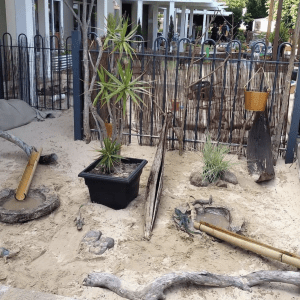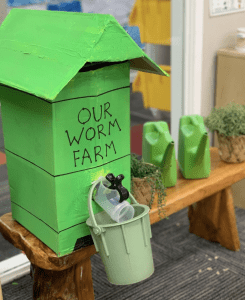Here at Kinderloop, we often come across some awe-inspiring humans. One of which is Tracey, an educator extraordinaire who shares some of her inspiring play spaces on social media https://www.instagram.com/places_spaces_wonder_delight/
We often share Tracey’s beautifully curated setups, as we know it can feel hard to be inspired day in day out. We contacted Tracey to give our Kinderloop community some amazing ideas on how to create beautiful and thought-provoking set ups.
We always feel totally inspired when we see your ideas on social media. Can you tell us a little bit about yourself?
My name is Tracey, and I’ve worked in Early Childhood for 17 years.
I’ve also only ever worked at one centre for this entire time, therefore I’ve seen many changes during these years.
From brightly coloured plastic, to now a calm, more neutral space where my focus is on nature.
I have a qualification in Floristry and Visual Merchandising which help me draw inspiration for my setups.
I have a keen eye for detail and I’m always authentic and respectful in the spaces I create. A big passion of mine is teaching First Nations culture through my love of Country, Art, Music and History.
What are your top 3 elements to consider when planning and setting up a play space?
Is there nature or natural resources?
Is the space authentic and does it have an element of awe and wonder?
Is it meaningful to the children and ask yourself ‘where is the learning?’
Educators can often feel uninspired with the same resources, do you have any tips to incorporate budget-friendly ideas?
I’m definitely into budget-friendly resources and although I love seeing beautiful wooden and felt resources on Instagram, sometimes these are totally out of my reach due to the price.
I love sourcing op-shops, and markets, and I’ll often have a vision of how I’ll use an item, even if it’s the most obscure thing. I often head to Reverse Garbage for a fossic, and Antique Markets if the price is right.
Community pages and groups on Facebook as well as Facebook Marketplace can be a great source for bargains too.
Most of the time my eyes are on the look out for rocks, sticks, and are all stored in my garage for future use. When you’re not actually looking is when the things just seem to appear.
What has been the most successful play space you have set up and why?
I dont think I have any one particular play space, but I think anything that is First Nations inspired are always my favourites to do. Especially when I get feedback from First Nations people or businesses, and they share my pictures on social media. This makes me very proud of how I’ve respected their culture and the way I’ve passed this on to my children.
We can see you enjoy using natural materials in your spaces. What are some of your favourite items?
Some of favourites include:
STICKS & BRANCHES – which can be put in the trees for climbing and swinging, cut up into small pieces to make tree people, or sliced for numeracy & literacy activities (I use a burner to write on them)
LEAVES – painted or used to write on for displays, bunches of gum leaves in or around any set up looks amazing, and brings in a natural element even if there is plastic involved.
PODS ETC – in a small world play ie. boats, fairy gardens ie.houses or beds.
ROCKS & PEBBLES – writing/ mark making with water or just as a calm activity. Used for painting fruit and vegetables on in Home Corner or Outdoor Kitchen. Wishing stones (ones with lines) are great for creating patterns. Also stacking and sequencing.
BAKSIAS – playdough printing and patterns, wool wrapping, and when teaching about First Nations use.
FLOWERS – water play/ outdoor kitchen, playdough, sensory play and art.
Do you have any tips for educators to embed cultural perspectives effectively into their play spaces?
- Firstly educate yourself on the history and culture of your local area so you have a good understanding before you begin to teach the children.
- Don’t be scared to try. If it’s coming from a good place you’ll never offend or wrong.
- Always be authentic with your resources and acknowledge where they are bought from or the artist. Be respectful.
- Collect and use nature from the Country you are on. It helps children make that connection.
- Go into your community and meet and talk to people. I have First Nation friends who are Educators, artists, business owners, musicians and Drag Queens. This gives you a real perspective from everyday First Nations people.
- Follow as many First Nations people on social media including businesses, artists, activists, musicians etc.
- Visit places like The Blak Markets here in Sydney to see and learn, and buy direct from First Nations people.
- Get excited and project your excitement onto your children. I’m very proud to live in a country with the oldest living culture and I’m learning everyday too!
- Create a morning Acknowledgement of Country that the children look forward to each day. In my room, I made cardboard box squares with the symbol for sitting on them which I place on the floor in a circle shape. In the centre is another symbol for campsite/ meeting place. We have a wooden board with Aboriginal peg dolls, a gunyah, nature basket, clapping sticks and Aboriginal painted stones. These items are brought to the centre of the circle and the children choose a stone to hold. Then they tell me what each stone means to them ie. water, trees, flowers, skin colour, and Aboriginal Flag. All these things help them make a connection to the land and has become a ritual they look forward to each morning.
Thank you for sharing some wonderful tips Tracey!
Check out Tracey’s social media pages for more inspiration https://www.instagram.com/places_spaces_wonder_delight/
Happy Kinderlooping!
Follow along on our social pages to ensure you don’t miss out on all of the Kinderloop tips & hints, and learn about our new features!
Facebook
Instagram


















